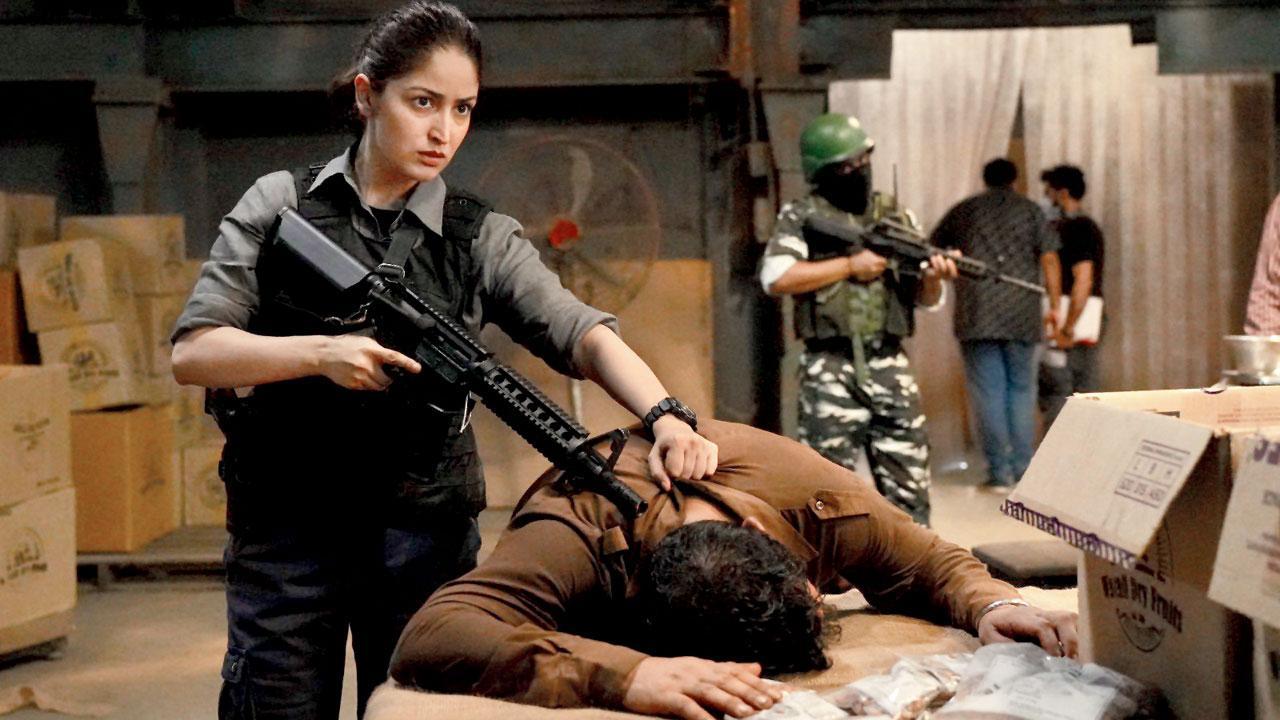Is it fact, or fiction—it’s the ‘in-between’ that confuses audiences weaving history in their heads, no?

A still from Aditya Suhas Jambhale’s Article 370
 370 is both the Article in the Indian Constitution abrogated by the Central government on August 5, 2019, and the number of seats Prime Minister Narendra Modi said his Bhartiya Janata Party (BJP) must aim to secure in the 2024 general elections.
370 is both the Article in the Indian Constitution abrogated by the Central government on August 5, 2019, and the number of seats Prime Minister Narendra Modi said his Bhartiya Janata Party (BJP) must aim to secure in the 2024 general elections.
Article 370 is also a Bollywood film, directed by debutant, Aditya Suhas Jambhale, produced by Aditya Dhar (Uri).
ADVERTISEMENT
What, exactly, does Article 370 vis-à-vis Jammu & Kashmir (J&K) mean for fellow Indians? The film doesn’t reveal that in sufficient detail.
Desis, from a distance, have probably looked at Article 370 as accorded privilege that disallowed non-locals from owning real estate in J&K. Which, by and large, is still true for Himachal Pradesh, Nagaland, Sikkim, Arunachal Pradesh and Uttarakhand.
The film’s lead character, intelligence officer Zooni (Yami Gautam), contends that abrogating Article 370 may not altogether solve Kashmir’s issues/problems, but at least it makes it India’s.
Meaning: “Ek desh mein do vidhan, do pradhan aur do nishaan nahin challenge (A single country can’t have two constitutions, two prime ministers, and two national emblems)”—as per the writer, therefore a character, in the film.
That’s actually a line, verbatim, by Syama Prasad Mookerjee, founder of Bharatiya Jana Sangh (precursor to BJP). He’s not credited anywhere in the movie.
Abrogation of Article 370 had been Jana Sangh’s political demand since the early 1950s. It showed up in the recent Atal Bihari Vajpayee biopic, Main Atal Hoon (2024). Except, you observe barrels of guns in those supposedly ’50s portion of the movie. Terrorism in J&K began in the late 1980s.
Between building Ram Temple in Ayodhya, BJP’s electoral promise since 1989, and the scrapping of Article 370—politician and data-analyst Prashant Kishor argues that it’s the latter, which must have moved the needle for BJP gathering “incremental” support from among swing/undecided voters.
Shortly after the Ayodhya temple consecration, actor Arun Govil, aka Lord Ram from TV serial Ramayan, shows up in Article 370, as the Indian Prime Minister, clearly costumed on PM Modi, looking grim and introspective, throughout.
Likewise, the home minister, called Madhav Patel (no relation to politician Ram Madhav), is obviously modelled on Amit Shah, chief architect of the Article 370 abrogation.
Which, as a bill, gets tabled in the Rajya Sabha (RS) first. Only, the leader of opposition in the RS here, bearing resemblance to no one, is named Rohit Thapar. Isn’t he supposed to be Ghulam Nabi Azad, a man from J&K himself?
The film starts from 2015-16, with the killing of the militant, Burhan Wani, who’s still very much Burhan Wani, while his close aide, Zakir Musa (Zakir Rashid Bhat), subsequently gunned down in 2019, is named Zakir Naiku! Why; kai-ku? You wonder.
Or you don’t, because that’s not how we watch movies, with entertainment as its primary purpose, where form often becomes content in itself.
That, in this case, concerns the crackerjack, opening shoot-out sequences, followed by some stellar scenes directed at the mob, storming a military convoy.
At the centre is the female lead, Gautam, delivering a solid performance—taking direct orders from her female boss, Priyamani, playing a joint secretary in the Prime Minister’s Office.
In the lead-up, you also watch the infamous attack on CRPF jawans, that took place in Pulwama, which was equally emotionally exploited in the film, Fighter (2024), a fully ‘Bollywood’ account of the Balakot air-strikes thereafter, that people know so little about.
As with some picture, Ranneeti: Balakot & Beyond, on its way. Or Dhar’s eponymous Uri: The Surgical Strike (2019), that we’ve no option but to assume as true; for, what else do we know?
Article 370 is similarly an action film, on what’s properly a policy/political decision. Which, in turn, pans out with enough excitement over legalese, lifting even parliamentary proceedings with a thumping background score.
Its point obviously is to show how the historic scrapping of a contentious piece of post-independence legislation took place without any civilian death in J&K—metaphorically a bloodless coup, as it were. Which is correct.
You’d think it’s primarily because of two women, in Delhi, and Kashmir—not even a geopolitical mention of the state of Pakistan, sponsor of J&K terrorism, in economic ruin!
Who reads the convenient disclaimer that starts with, “This film is a fictional work…” Followed by the prominent opening slate plus poster that states: “Inspired by true events.” Inspiration needs no citations.
The PM, as also in the film’s trailer, says, “Agar humein itihaas likhna hai, toh kisi na kisi ko itihaas banana padega (Someone has to make history, in order to write it).”
Except, it’s a line, verbatim, by Lt General ‘Tiny’ Dhillon, who was heading Kashmir counter-insurgency, both during Pulwama; destroying Ghazi, its mastermind; and the abrogation of Article 370.
Few will read Dhillon’s memoir, Kitne Ghazi Aaye Kitne Ghazi Gaye, as they will watch Article 370 for history! Sure, the film’s a polemic, as in it pushes only a particular POV.
I know truth has multiple versions, and the narrative of the victor inevitably wins. But what kinda militaristic nationalist film erases the Indian Army?
I’m wondering what if this film was a journalistic piece. Well, the only on-ground journalist I’ve met in Kashmir (union territory) since 2019 is busy doing stories on water-chestnut farming. Hmmm… Good then!
Mayank Shekhar attempts to make sense of mass culture. He tweets @mayankw14
Send your feedback to mailbag@mid-day.com
The views expressed in this column are the individual’s and don’t represent those of the paper.
 Subscribe today by clicking the link and stay updated with the latest news!" Click here!
Subscribe today by clicking the link and stay updated with the latest news!" Click here!








